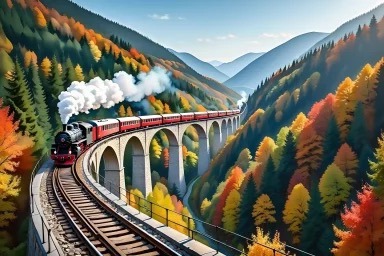The Semmering Railway: Austria’s Spiraling Ode to Mountain Drama and 19th-Century Brilliance
The Semmering Railway connects Gloggnitz in Lower Austria to Mürzzuschlag in Styria, running through the Semmering Pass in the eastern Alps. It climbs over 450 vertical meters in just 41 kilometers, using 14 tunnels, 16 viaducts, 100+ stone bridges, and more than 60 subtly impossible curves to make the ascent feel smooth and scenic instead of suicidal.
UNESCONATUREECHOES OF ELSEWHEREHISTORYEUROPEAUSTRIATRAINSMOUNTAINS


Semmering Pass, Lower Austria & Styria
At first glance, it’s just a train ride. But within a few bends of the track - sharp ones, mind you - you realize you’ve boarded one of Europe’s most absurdly scenic, gravity-defying, and historically outrageous transport marvels: the Semmering Railway.
This isn’t your average commuter route. This is a UNESCO-listed, 41-kilometer corkscrew of viaducts, tunnels, forests, and Alpine wonder, where locomotives cling to mountainsides like polite mountaineers and passengers routinely drop their jaws somewhere near the second tunnel.
Built in the 1850s, during the age of empires, moustaches, and grand engineering gestures, this was the world’s first true mountain railway. And rather than bulldozing through the landscape, it embraced it - waltzing its way through the Semmering Pass in a feat so bold and beautiful, people thought the engineers had lost their minds. Fortunately, they hadn’t. They just had a flair for drama.
So whether you’re searching for “Semmering Railway Austria,” “UNESCO mountain railways,” or “most scenic train rides in Europe,” hop aboard. This one’s for you.
What (and Where) Is the Semmering Railway?
The Semmering Railway connects Gloggnitz in Lower Austria to Mürzzuschlag in Styria, running through the Semmering Pass in the eastern Alps. It climbs over 450 vertical meters in just 41 kilometers, using 14 tunnels, 16 viaducts, 100+ stone bridges, and more than 60 subtly impossible curves to make the ascent feel smooth and scenic instead of suicidal.
It was the brainchild of Carl Ritter von Ghega, a Venetian-born Austrian engineer who looked at the Alps and thought, “Sure, I can train through that.” And train through it he did. Opened in 1854, the route became a symbol of what engineering and ambition could achieve - namely, moving rich people quickly to their mountain villas.
Today, it still carries modern trains, scenic services, and the occasional rail enthusiast making audible sighs out the window.
Riding the Semmering: What to Expect (Besides Wanting to Move to Austria)
You can hop on the Semmering line via regional ÖBB trains between Vienna and Graz, which regularly traverse the full route. But for maximum experience, start in Gloggnitz and ride all the way to Mürzzuschlag - preferably with a thermos of coffee and no deadline.
Here’s what you’ll get:
· Dizzying loops and switchbacks, which somehow never feel abrupt
· Panoramic Alpine views, framed by dense forests, meadows, and gravity-defying bridges
· Architectural treats like the Kalte Rinne Viaduct (a double-arched beauty) and the Polleroswand Tunnel
· Glorious silence interrupted only by the train’s rhythmic clatter and your quiet gasps
There’s something meditative about watching a landscape unfold from a carriage window while knowing it’s the same view emperors and aristocrats once admired.
Stops, Views & Detours Worth the Time
1. Semmering Town
A charming resort town once beloved by Habsburgs and high society, Semmering is perched halfway along the line and still brims with Belle Époque villas, cozy cafés, and vintage ski vibes. Pop off the train for a stroll through pine-scented air and grand old hotels.
2. Semmering Railway Museum (in Mürzzuschlag)
It may not sound thrilling, but trust us - it’s fascinating. From antique railcars to interactive exhibits, the Südbahn Museum offers deep dives into the railway’s history, the lives of workers, and the mind-bending construction process (spoiler: pickaxes and sheer willpower).
3. 20-Schilling Viewpoint (20-Schilling Blick)
Named after the iconic currency note that once featured the Semmering landscape, this lookout point offers a perfect shot of the Kalte Rinne Viaduct nestled in the valley. It’s like looking at an old postcard - but real.
4. Hiking the Bahnwanderweg (Railway Hiking Trail)
Prefer to walk alongside your historical infrastructure? You can. The Semmering Bahnwanderweg is a 23-km trail that lets you hike parallel to the tracks, through woods, past tunnels, and over scenic hills - with frequent encounters with history, interpretive signs, and polite Austrian cows.
Best Time to Ride the Semmering Railway
· Spring: Wildflowers, green slopes, and bright air. Bonus: fewer crowds.
· Summer: Lush views and perfect picnic weather. Hike, ride, repeat.
· Autumn: Gold and copper leaves make every viaduct look like a painting. Highly recommended.
· Winter: The Alps under snow are chef’s kiss, and the route passes by ski resorts blanketed in magic.
Honestly, the Semmering Railway is one of those rare marvels that’s beautiful in every season - just bring the right coat and camera.
What to Pack (Besides a Healthy Appreciation for 19th-Century Genius)
Camera or phone with panoramic mode – you’ll want wide shots of the viaducts
Layers – mountain weather has mood swings
Snacks or a train picnic – treat yourself like Habsburg nobility
Binoculars – yes, you’ll be that person, and you’ll love it
Walking shoes – for optional detours to viewpoints and nearby towns
An Austrian Rail Pass – if you're hopping on and off multiple times
Fun Questions Worth Asking
Can I ride this with a Eurail Pass?
Yes, you majestic rail wanderer, you can. ÖBB regional trains are covered.
Do you need a special scenic train?
Not at all. Standard ÖBB regional trains serve the route, and the views are glorious from any window. If you want more vintage flair, check for seasonal heritage steam trains.
How long is the ride?
From Gloggnitz to Mürzzuschlag, about 1 hour - but you’ll wish it were longer.
Is it suitable for families or solo travelers?
Absolutely. Whether you’re a kid obsessed with trains or an adult who still is, this ride charms everyone.
Final Thought: A Track Through Time, Curved by Genius
The Semmering Railway isn’t just about getting from A to B. It’s a journey back into the golden age of travel - when the process of reaching the mountains was part of the adventure, not just the prelude.
It reminds us that humans, when properly caffeinated and challenged by topography, can build miracles. And sometimes, those miracles involve viaducts clinging to cliffs, trains peeking out of tunnels, and Alpine light streaming through pine trees like a blessing.
So take the ride. Let the train hum through the mountains. And tip your hat (real or imaginary) to Carl von Ghega and the mad genius of building elegance through stone and steel.




